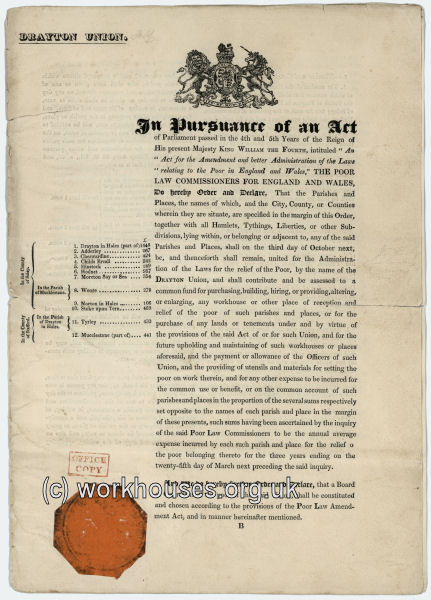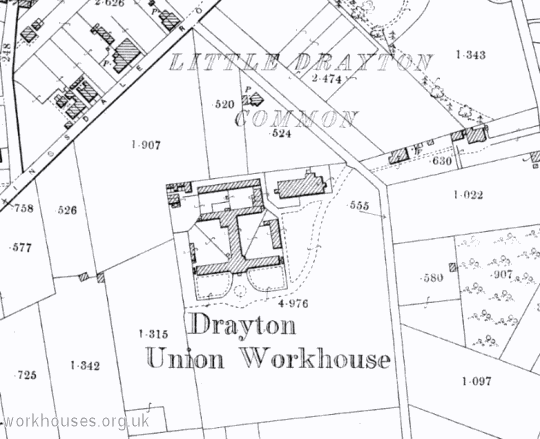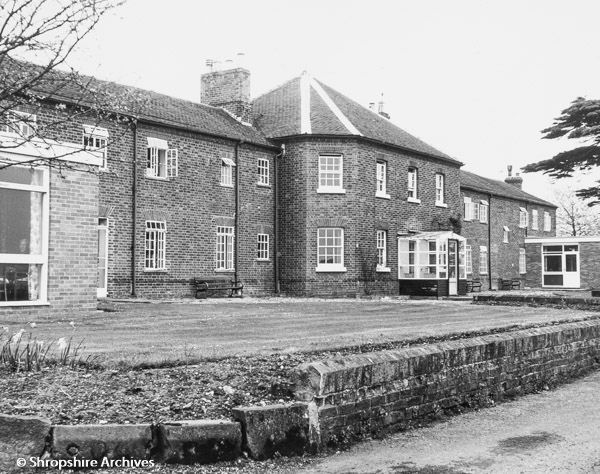(Market) Drayton, Shropshire
Up to 1834
In 1730, the will of Richard Price, vicar of Drayton, left funds for the creation of the town's first workhouse. A workhouse was established by 1757 at the south side of Shropshire Street, Drayton, at the modern-day junction with The Old Armoury. In 1777, the building could house up to 75 inmates.
In 1777, Hodnett had a workhouse for up to twenty paupers. In the 1830s, workhouses were also in operation at Spoonley and Cheswardine.
After 1834
The Drayton Poor Law Union formally came into being on 3rd October 1836. (In early years it was also known as the Drayton in Hales Union. In later later years, it became more commonly known as Market Drayton.) Its operation was overseen by an elected Board of Guardians, 18 in number, representing its 12 constituent parishes as listed below (figures in brackets indicate numbers of Guardians if more than one):
County of Salop:
Adderley, Cheswardine (2), Child's Ercall, Drayton in Hales — part of (4), Hinstock, Hodnet (2), Moreton Say or Sea, Woore — Parish of Mucclestone [Mucklestone], Norton in Hales, Stoke-upon-Tern (2)
County of Stafford:
Tyrley — Parish of Drayton Hales, Mucclestone [Mucklestone].
Later Additions: Ashley (from 1837), Market Drayton (from 1914), Sutton-upon-Tern (from 1914), Tittenley.
The population falling within the union at the 1831 census had been 12,999 with parishes ranging in size from Norton in Hales (population 311) to Drayton in Hales (3,882). The average annual poor-rate expenditure for the period 1834-36 had been £5,598 or 8s.7d. per head of the population.

Document from Poor Law Commissioners detailing the creation of the Drayton Union, 1836.
© Peter Higginbotham.
Initially, the new union continued using the Shropshire Street workhouse which was enlarged to increase its capacity to one hundred inmates. A new Drayton Union workhouse was erected in 1852-3 at Little Drayton Common on the south side of Buntingsdale road. Designed by Thomas D Barry, it could accommodated 128 inmates. The workhouse location and layout are shown on the 1902 map below.

Drayton workhouse site, 1902.

Former Drayton workhouse from the south-west, 1965.
© Shropshire Archives.
The main building was a truncated version of the popular 'square' layout, lacking the usual entrance block and its rear range. In the resulting T-shaped layout, the octagonal central hub and side-wings formed the frontage of the building. The hub contained receiving wards to the front and Master's quarters to the rear. The west wing contained a boy's day school and able-bodied men's day rooms, with dormitories above. The east wing contained equivalent accommodation for women and girls. The north wing contained the kitchens. Blocks for aged paupers and isolation wards were at the rear. Plans from 1899 show a proposed infirmary at the north-east with a two storey central portion and single storey wings at each side. It included a nurses' room and a lying-in ward over the centre.
After 1930, the sit was taken over by Shropshire County Council and became a Public Assistance Institution known as Quarry House. It continued in use as a welfare home until about 1990.
The former workhouse buildings have now been demolished and a housing estate now occupies the site.
Staff
Inmates
Records
Note: many repositories impose a closure period of up to 100 years for records identifying individuals. Before travelling a long distance, always check that the records you want to consult will be available.
- Shropshire Archives, Castle Gates, Shrewsbury, Shropshire SY1 2AQ. Please note that records may contain gaps or have access restrictions - please check before visiting. Limited holdings include Guardians' minutes (1836-1930); Ledgers (1836-1930); etc.
Bibliography
- Higginbotham, Peter The Workhouse Encyclopedia (2014, The History Press)
Links
- None.
Unless otherwise indicated, this page () is copyright Peter Higginbotham. Contents may not be reproduced without permission.


